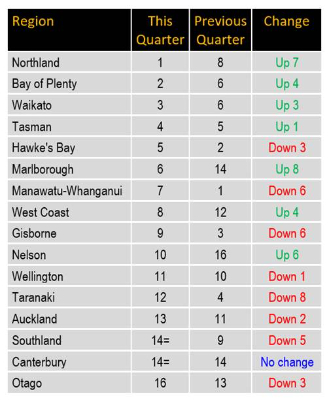Northland And New Zealand’s Rural Sector Steal The Show In The Latest ASB Regional Economic Scoreboard

- Northland climbs seven spots to take top place
- Rural New Zealand dominates this quarter with Bay of Plenty and Waikato rounding out the top three
- The North Island is still the place to be as the South Island trails
- Taranaki dropped eight spots, slipping from fourth to 12th after a mediocre quarter
The winterless North takes the lead
A strong performance from Northland this quarter has seen the region shoot up seven spots to take the lead in ASB’s quarterly Regional Economic Scoreboard.
ASB senior economist Chris Tennent-Brown says, “It’s an impressive performance given the region would have been more exposed than most to Auckland’s move to COVID Alert Level 3 in August,” although he notes the figures reflect year-on-year growth and the recovery from a tough 2019 will be helping boost Northland’s rankings.
“This quarter’s result reflects an upswing, though there is still a way to go, with the unemployment rate above the national average. Still, it’s positive to see some catch-up momentum getting underway.”
The ASB Regional Economic Scoreboard shows solid population growth, employment, retail and new car sales figures for Northland this quarter, with Mr Tennent-Brown highlighting the forestry sector as one of the standouts of the post-pandemic economy.
“Forestry exports are performing strongly thanks to the rapid Chinese recovery, and the booming domestic construction outlook is also acting as a key support. Forestry products are one of the few commodities where prices largely match last year. Overall a solid performance from the North this quarter.”
Rural New Zealand the star of the show
Whilst the main centres had a softer quarter, rural New Zealand is holding up well with Bay of
Plenty and Waikato taking silver and bronze respectively, thanks to their heavy agricultural focus.
The stronger outlook for the dairy sector of late is one factor, along with a record Kiwifruit season in the Bay, and solid export activity.
“All the regions with dairy exposure will be pleased to note we have lifted our farmgate milk price forecast to $7 recently.
“The primary sector’s resilience is really pleasing to see. Most obviously, food production is an essential service, so farmers have just kept doing a great job while their peers in the service sector dealt with the fear of further lockdowns. With borders largely closed to the movement of people, tourism is hurting, and that’s having a negative flow-on effect on related sectors, like retail trade. So it’s not surprising to see regions that are more reliant on agriculture and exports experiencing the benefits,” says Mr Tennent-Brown.
Waikato is seeing the positives from having low unemployment as well as robust annual growth and strong retail sales, although non-residential construction looks to be slowing slightly this year.
Meanwhile, Bay of Plenty residents were the most upbeat across the country this quarter, despite the lack of international tourism dollars that the region usually enjoys. “Hopefully there is a big domestic tourism influx over the summer as the festival season begins.”
South Island still trailing as the North Island dominates the upper half of the scoreboard
The North Island continues to outperform the south, with Otago, Southland and Canterbury all remaining at the bottom of the ladder this quarter.
“South Island regions have traditionally relied more heavily on international tourist earnings than most North Island regions, and we’re seeing this continue to take a toll. It’s highly likely that until we get a vaccine and tourism begins to pick up, we will continue to see the relative industry impacts reflected in regional economic success,” says Mr Tennent-Brown.
Softer metrics across the board hindered Otago and Canterbury’s progress this quarter, however, for Southland, which fell five spots to 14th, the potential closure of the Rio Tinto plant likely weighed on sentiment.
Taranaki has the biggest drop this quarter
It was a tough quarter for Taranaki with the region sliding eight spots to 12th.
“The two big industries in the region are pointing in different directions. The energy sector faces an uncertain future as energy prices trundle along historic lows. That’s having a wider flow-on effect in the region and, last month, we saw Methanex announce it would shut its methanol plant in Waitara, after failing to secure new gas supplies.”
Despite sitting in the lower half of the table for most metrics, including population growth, employment, construction and house sales, Taranaki’s strong dairy sector would likely be a support in coming months says Mr Tennent-Brown.
The full ASB Regional Economic Scoreboard, along with other recent ASB reports covering a range of commentary, can be accessed at our ASB Economic Insights page: https://www.asb.co.nz/documents/economic-insights.html
@ASBBank @ASBMarkets www.asb.co.nz



 John Mazenier: Gaffer Tape And Glue Delivering New Zealand’s Mission Critical Services
John Mazenier: Gaffer Tape And Glue Delivering New Zealand’s Mission Critical Services Earthquake Commission: Ivan Skinner Award Winner Inspired By Real-life Earthquake Experience
Earthquake Commission: Ivan Skinner Award Winner Inspired By Real-life Earthquake Experience Reserve Bank: Consultation Opens On A Digital Currency For New Zealand
Reserve Bank: Consultation Opens On A Digital Currency For New Zealand NIWA: Ship Anchors May Cause Extensive And Long-lasting Damage To The Seafloor, According To New Research
NIWA: Ship Anchors May Cause Extensive And Long-lasting Damage To The Seafloor, According To New Research New Zealand Customs Service: A Step Forward For Simpler Trade Between New Zealand And Singapore
New Zealand Customs Service: A Step Forward For Simpler Trade Between New Zealand And Singapore Horizon Research: 68% Say Make Banks Offer Fraud Protection
Horizon Research: 68% Say Make Banks Offer Fraud Protection



